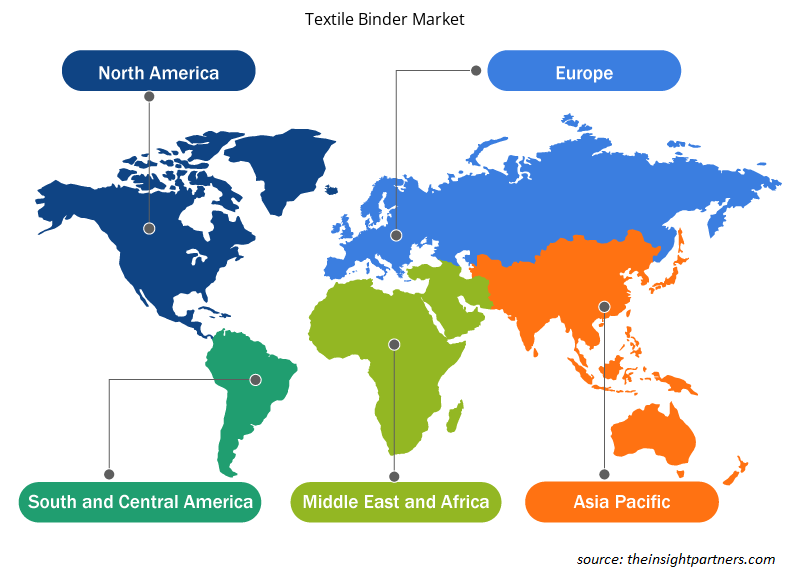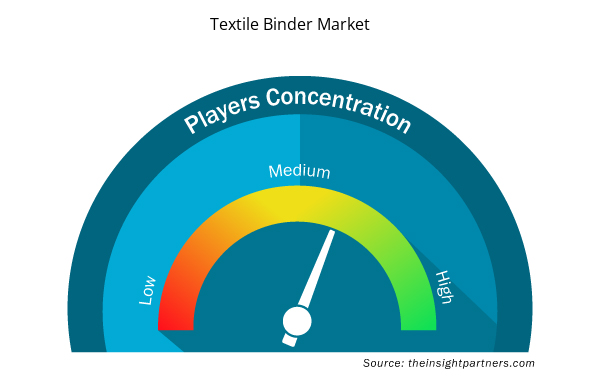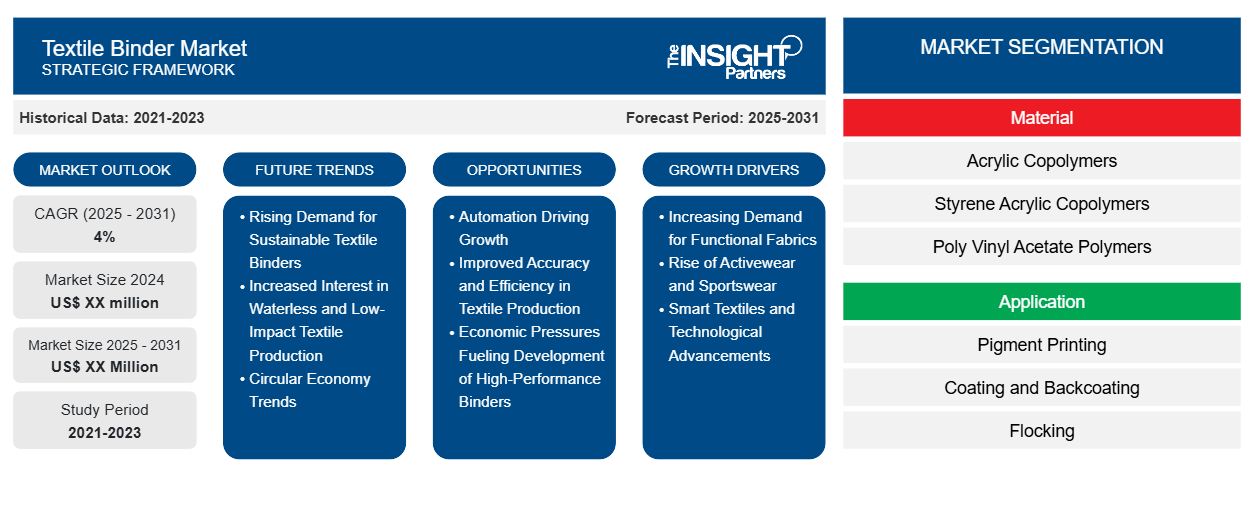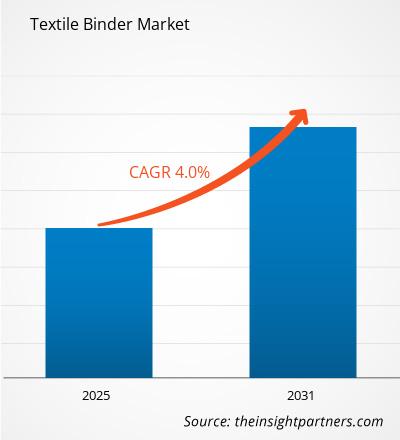Se espera que el mercado de aglutinantes textiles registre una CAGR del 4% entre 2024 y 2031, con un tamaño de mercado que se expandirá de US$ XX millones en 2024 a US$ XX millones en 2031.
El informe presenta un análisis basado en el material (copolímeros acrílicos, copolímeros acrílicos de estireno, polímeros de acetato de polivinilo, copolímeros acrílicos de vinilo y otros). El informe está segmentado por aplicación (impresión con pigmentos, recubrimiento y revestimiento posterior, flocado y otros). El análisis global se desglosa aún más a nivel regional y por países principales. El tamaño del mercado y el pronóstico a nivel global, regional y nacional para todos los segmentos clave del mercado están cubiertos bajo el alcance. El informe ofrece el valor en USD para el análisis y los segmentos anteriores. El informe proporciona estadísticas clave sobre el estado del mercado de los actores clave del mercado y ofrece tendencias y oportunidades del mercado.
Propósito del Informe
El informe Textile Binder Market de The Insight Partners tiene como objetivo describir el panorama actual y el crecimiento futuro, los principales factores impulsores, los desafíos y las oportunidades. Esto proporcionará información a diversas partes interesadas del negocio, como:
- Proveedores/fabricantes de tecnología: Para comprender la dinámica cambiante del mercado y conocer las oportunidades potenciales de crecimiento, lo que les permitirá tomar decisiones estratégicas informadas.
- Inversionistas: Realizar un análisis exhaustivo de tendencias sobre la tasa de crecimiento del mercado, las proyecciones financieras del mercado y las oportunidades que existen en toda la cadena de valor.
- Órganos reguladores: Regular las políticas y vigilar las actividades del mercado con el objetivo de minimizar los abusos, preservar la confianza de los inversores y defender la integridad y la estabilidad del mercado.
Segmentación del mercado de aglutinantes textiles
Material
- Copolímeros acrílicos
- Copolímeros acrílicos de estireno
- Polímeros de acetato de polivinilo
- Copolímeros de vinilo acrílico
Solicitud
- Impresión con pigmentos
- Recubrimiento y revestimiento posterior
- Flocado
Personalice este informe según sus necesidades
Obtendrá personalización en cualquier informe, sin cargo, incluidas partes de este informe o análisis a nivel de país, paquete de datos de Excel, así como también grandes ofertas y descuentos para empresas emergentes y universidades.
- Obtenga las principales tendencias clave del mercado de este informe.Esta muestra GRATUITA incluirá análisis de datos, desde tendencias del mercado hasta estimaciones y pronósticos.
Factores impulsores del crecimiento del mercado de aglutinantes textiles
- Increasing Demand for Functional Fabrics : Growth in demand for functional fabrics is a prime cause of market growth in textile binders. The differential properties such as moisture-wicking, anti-microbial, and UV protection are all responsible for requiring special binders to maintain these properties within the final product. The growth in consumer interest in high-performance textiles is thus directly reflected in the demand for binders for these functionalities.
- Rise of Activewear and Sportswear: Additionally, the growing demand for activewear and sportswear also increases functional fabric demand. Binders are essential in the production of such clothing as they maintain the form, texture, and function-enabling properties. This performance apparel trend propels the textile binder market as the producers look forward to having more efficient binders for these applications.
- Smart Textiles and Technological Advancements: The growing interest in smart textiles, with technology like sensors and conductive materials integrated into these fabrics, has driven demand upward. These advanced fabrics are in significant demand for binders that can support and not interfere with new high-tech manufacturing methods for embedded electronics. Continued innovation in such smart textiles is driving this market to new heights.
Textile Binder Market Future Trends
- Rising Demand for Sustainable Textile Binders: Increased demand for sustainable textile production is also a strong propeller in the textile binders market. Increased attention has garnered from manufacturers as end users are becoming ultra-green in most textile products around the world. That's because using biodegradable or renewable-based sustainable binders reduces environmental burden during fabric production and, at the same time, keeps pace with consumers' demand for greener textiles.
- Increased Interest in Waterless and Low-Impact Textile Production: Textile manufacturers increasingly show interest in sustainable processes such as waterless dyes through fewer chemicals. In other words, it is a fact that the requirement for binders is going to increase since these are integrated into complementary processing. Sustainable binders are likely to be in more demand because they are better suited to low-impact production processes. Thus, such binders would especially be chosen by customers as they meet preferred compliance with standards and objectives such as environment.
- Circular Economy Trends: The shift from the previous disposition to the use of sustainable binders for textiles is the rise in circular economy models. Those would be types of binders that will facilitate recycling recovery and reuse of fabrics in the emerging closed-loop system. Given that sustainability is and will be ever on the rise among brands and consumers, so will it, with textile binders speaking the language of circularity.
Textile Binder Market Opportunities
- Automation Driving Growth: Advancements in the automation of textile manufacturing have opened opportunities for growth in the textile binder market. As automation technology improves and optimizes textile manufacturing processes, it generates a need for efficient binders that can function in high-speed and high-volume production lines. Added performance and systemic compatibility thereby drive potential demand in the textile binder market.
- Improved Accuracy and Efficiency in Textile Production: Automation increases uniformity in binder application, for example, in the textile production process, which improves the accuracy in the production of textiles. This remains a parameter that helps in the control of the final fabric properties, including durability, texture, and colorfastness. The high-performance binders that support these improvements in efficiency and quality in the manufacturing processes have greater demands, hence boosting the market.
- Economic Pressures Fueling Development of High-Performance Binders: New binder developments from the economic pressures of automated textile manufacturing processes. Greater use of easy applications with maintained performance and efficacy in such environments gives rise to a need. High demand from making the binders be developed to complete the tasks of simply integrating into automated production lines without loss of functionality further expands the opportunity.
Textile Binder Market Regional Insights
The regional trends and factors influencing the Textile Binder Market throughout the forecast period have been thoroughly explained by the analysts at Insight Partners. This section also discusses Textile Binder Market segments and geography across North America, Europe, Asia Pacific, Middle East and Africa, and South and Central America.

- Get the Regional Specific Data for Textile Binder Market
Textile Binder Market Report Scope
| Report Attribute | Details |
|---|---|
| Market size in 2024 | US$ XX million |
| Market Size by 2031 | US$ XX Million |
| Global CAGR (2024 - 2031) | 4% |
| Historical Data | 2021-2023 |
| Forecast period | 2025-2031 |
| Segments Covered | By Material
|
| Regions and Countries Covered | North America
|
| Market leaders and key company profiles |
|
Textile Binder Market Players Density: Understanding Its Impact on Business Dynamics
El mercado de aglutinantes textiles está creciendo rápidamente, impulsado por la creciente demanda de los usuarios finales debido a factores como la evolución de las preferencias de los consumidores, los avances tecnológicos y una mayor conciencia de los beneficios del producto. A medida que aumenta la demanda, las empresas amplían sus ofertas, innovan para satisfacer las necesidades de los consumidores y aprovechan las tendencias emergentes, lo que impulsa aún más el crecimiento del mercado.
La densidad de actores del mercado se refiere a la distribución de las empresas o firmas que operan dentro de un mercado o industria en particular. Indica cuántos competidores (actores del mercado) están presentes en un espacio de mercado determinado en relación con su tamaño o valor total de mercado.
Las principales empresas que operan en el mercado de aglutinantes textiles son:
- Productos químicos 3J
- Arqueroma
- Arkema SA
- Camex limitada
- Bajar
Descargo de responsabilidad : Las empresas enumeradas anteriormente no están clasificadas en ningún orden particular.

- Obtenga una descripción general de los principales actores clave del mercado de aglutinantes textiles
Puntos de venta clave
- Cobertura integral: el informe cubre de manera integral el análisis de productos, servicios, tipos y usuarios finales del mercado de aglutinantes textiles, proporcionando un panorama holístico.
- Análisis de expertos: el informe se compila sobre la base de un profundo conocimiento de expertos y analistas de la industria.
- Información actualizada: El informe asegura relevancia comercial debido a su cobertura de información reciente y tendencias de datos.
- Opciones de personalización: este informe se puede personalizar para satisfacer los requisitos específicos del cliente y adaptarse adecuadamente a las estrategias comerciales.
Por lo tanto, el informe de investigación sobre el mercado de aglutinantes textiles puede ayudar a abrir camino para descifrar y comprender el escenario de la industria y las perspectivas de crecimiento. Si bien puede haber algunas preocupaciones válidas, los beneficios generales de este informe tienden a superar las desventajas.
- Análisis histórico (2 años), año base, pronóstico (7 años) con CAGR
- Análisis PEST y FODA
- Tamaño del mercado Valor/volumen: global, regional, nacional
- Industria y panorama competitivo
- Conjunto de datos de Excel



Report Coverage
Revenue forecast, Company Analysis, Industry landscape, Growth factors, and Trends

Segment Covered
This text is related
to segments covered.

Regional Scope
North America, Europe, Asia Pacific, Middle East & Africa, South & Central America

Country Scope
This text is related
to country scope.
Preguntas frecuentes
Sustainable textile manufacturing is expected to be the key market trends.
Based on geography, Asia Pacific held the largest share of the textile binder market, as the countries like China, India, and Bangladesh are major global textile hubs, driving significant demand for textile binders in processes such as dyeing, printing, and finishing. The region’s strong manufacturing infrastructure and low labor costs make it an attractive center for textile production.
Based on material, the acrylic copolymers segment is expected to witness the fastest growth during the forecast period
The growing demand for functional fabrics is driving the market growth.
Dow; Wacker Chemie AG; Arkema; Pioneer Chemicals; NANPAO RESINS CHEMICAL GROUP; CHT Group; Trinseo; Covestro AG; Scott Bader Company Ltd.; and Kemiteks are some of textile binder market
The Textile Binder Market is estimated to witness a CAGR of 4% from 2023 to 2031
Trends and growth analysis reports related to Chemicals and Materials : READ MORE..
1. 3J Chemicals
2. Archroma
3. Arkema S.A.
4. Camex limited
5. Dow
6. FCL
7. Hemanjali Polymers
8. OMNOVA Solutions Inc.
9. Pioneer Chemical, Inc
10. Scott Bader Company Ltd
The Insight Partners performs research in 4 major stages: Data Collection & Secondary Research, Primary Research, Data Analysis and Data Triangulation & Final Review.
- Data Collection and Secondary Research:
As a market research and consulting firm operating from a decade, we have published and advised several client across the globe. First step for any study will start with an assessment of currently available data and insights from existing reports. Further, historical and current market information is collected from Investor Presentations, Annual Reports, SEC Filings, etc., and other information related to company’s performance and market positioning are gathered from Paid Databases (Factiva, Hoovers, and Reuters) and various other publications available in public domain.
Several associations trade associates, technical forums, institutes, societies and organization are accessed to gain technical as well as market related insights through their publications such as research papers, blogs and press releases related to the studies are referred to get cues about the market. Further, white papers, journals, magazines, and other news articles published in last 3 years are scrutinized and analyzed to understand the current market trends.
- Primary Research:
The primarily interview analysis comprise of data obtained from industry participants interview and answers to survey questions gathered by in-house primary team.
For primary research, interviews are conducted with industry experts/CEOs/Marketing Managers/VPs/Subject Matter Experts from both demand and supply side to get a 360-degree view of the market. The primary team conducts several interviews based on the complexity of the markets to understand the various market trends and dynamics which makes research more credible and precise.
A typical research interview fulfils the following functions:
- Provides first-hand information on the market size, market trends, growth trends, competitive landscape, and outlook
- Validates and strengthens in-house secondary research findings
- Develops the analysis team’s expertise and market understanding
Primary research involves email interactions and telephone interviews for each market, category, segment, and sub-segment across geographies. The participants who typically take part in such a process include, but are not limited to:
- Industry participants: VPs, business development managers, market intelligence managers and national sales managers
- Outside experts: Valuation experts, research analysts and key opinion leaders specializing in the electronics and semiconductor industry.
Below is the breakup of our primary respondents by company, designation, and region:

Once we receive the confirmation from primary research sources or primary respondents, we finalize the base year market estimation and forecast the data as per the macroeconomic and microeconomic factors assessed during data collection.
- Data Analysis:
Once data is validated through both secondary as well as primary respondents, we finalize the market estimations by hypothesis formulation and factor analysis at regional and country level.
- Macro-Economic Factor Analysis:
We analyse macroeconomic indicators such the gross domestic product (GDP), increase in the demand for goods and services across industries, technological advancement, regional economic growth, governmental policies, the influence of COVID-19, PEST analysis, and other aspects. This analysis aids in setting benchmarks for various nations/regions and approximating market splits. Additionally, the general trend of the aforementioned components aid in determining the market's development possibilities.
- Country Level Data:
Various factors that are especially aligned to the country are taken into account to determine the market size for a certain area and country, including the presence of vendors, such as headquarters and offices, the country's GDP, demand patterns, and industry growth. To comprehend the market dynamics for the nation, a number of growth variables, inhibitors, application areas, and current market trends are researched. The aforementioned elements aid in determining the country's overall market's growth potential.
- Company Profile:
The “Table of Contents” is formulated by listing and analyzing more than 25 - 30 companies operating in the market ecosystem across geographies. However, we profile only 10 companies as a standard practice in our syndicate reports. These 10 companies comprise leading, emerging, and regional players. Nonetheless, our analysis is not restricted to the 10 listed companies, we also analyze other companies present in the market to develop a holistic view and understand the prevailing trends. The “Company Profiles” section in the report covers key facts, business description, products & services, financial information, SWOT analysis, and key developments. The financial information presented is extracted from the annual reports and official documents of the publicly listed companies. Upon collecting the information for the sections of respective companies, we verify them via various primary sources and then compile the data in respective company profiles. The company level information helps us in deriving the base number as well as in forecasting the market size.
- Developing Base Number:
Aggregation of sales statistics (2020-2022) and macro-economic factor, and other secondary and primary research insights are utilized to arrive at base number and related market shares for 2022. The data gaps are identified in this step and relevant market data is analyzed, collected from paid primary interviews or databases. On finalizing the base year market size, forecasts are developed on the basis of macro-economic, industry and market growth factors and company level analysis.
- Data Triangulation and Final Review:
The market findings and base year market size calculations are validated from supply as well as demand side. Demand side validations are based on macro-economic factor analysis and benchmarks for respective regions and countries. In case of supply side validations, revenues of major companies are estimated (in case not available) based on industry benchmark, approximate number of employees, product portfolio, and primary interviews revenues are gathered. Further revenue from target product/service segment is assessed to avoid overshooting of market statistics. In case of heavy deviations between supply and demand side values, all thes steps are repeated to achieve synchronization.
We follow an iterative model, wherein we share our research findings with Subject Matter Experts (SME’s) and Key Opinion Leaders (KOLs) until consensus view of the market is not formulated – this model negates any drastic deviation in the opinions of experts. Only validated and universally acceptable research findings are quoted in our reports.
We have important check points that we use to validate our research findings – which we call – data triangulation, where we validate the information, we generate from secondary sources with primary interviews and then we re-validate with our internal data bases and Subject matter experts. This comprehensive model enables us to deliver high quality, reliable data in shortest possible time.


 Obtenga una muestra gratuita de este informe
Obtenga una muestra gratuita de este informe